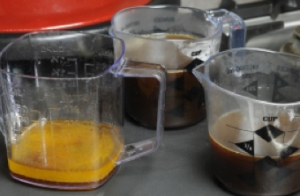Let's Talk About Saturated Fat
 What is Saturated Fat? Saturated fat is found mainly in animal foods, such as butter, milk and milk products, beef and pork, chicken skin, and lard. Coconut, palm and palm kernel oils are also saturated fats.Most health experts agree that a diet high in saturated fat increases your risk of heart disease by raising total cholesterol and LDL (bad) cholesterol.Saturated Fat and the American Diet: The largest sources of saturated fat in the American diet are:
What is Saturated Fat? Saturated fat is found mainly in animal foods, such as butter, milk and milk products, beef and pork, chicken skin, and lard. Coconut, palm and palm kernel oils are also saturated fats.Most health experts agree that a diet high in saturated fat increases your risk of heart disease by raising total cholesterol and LDL (bad) cholesterol.Saturated Fat and the American Diet: The largest sources of saturated fat in the American diet are:
- Cheese (full-fat)
- Pizza
- Grain-based desserts (cookies, etc)
- Dairy-based desserts (ice cream, milkshakes, etc)
- Chicken and chicken dishes
- Sausage, franks, bacon, and ribs
What about Coconut Oil? Coconut oil, a saturated fat, is the latest fad diet food. Its popularity is based on several claims that don't hold up under scrutiny:
- A study of Polynesian Islanders found low rates of heart disease despite a diet naturally rich in coconut meat and coconut oil.
- The study fails to mention the many other possible reasons for the Islanders' healthy hearts, such as a diet low in salt and cholesterol, and high in omega-3 fatty acids and fiber, as well as low tobacco use.
- About half of coconut oil's fatty acids are medium chain (MC) fatty acids. MC fatty acids are known to not raise blood cholesterol compared to long chain (LC) fatty acids.
- The problem is, the fatty acid given credit for coconut oil's protective effect is lauric acid, which is longer than most MC fatty acids, so some consider it to be a LC fatty acid. Regardless, a few studies have found that lauric acid improved the ratio of total cholesterol to HDL (good) cholesterol, but it also raised LDL (bad) cholesterol.
- Furthermore, one study found that a coconut-oil rich meal damaged blood vessels and altered HDL particles, reducing their anti-inflammatory properties.
Build a balanced diet that includes foods with saturated fat only in moderation. Eat more fruits, vegetables, whole grains, beans/legumes, and fish, lean meats and poultry. Eat less processed and fried foods. This way of eating translates to less "bad" fat, more "good" fat, and a healthy heart.By Hollis Bass, MEd, RD, LD


